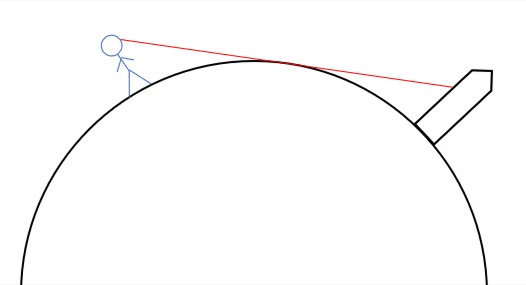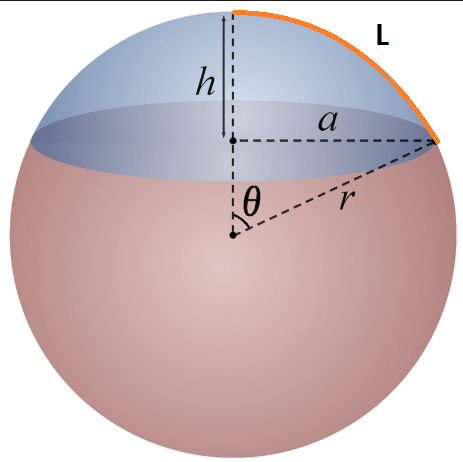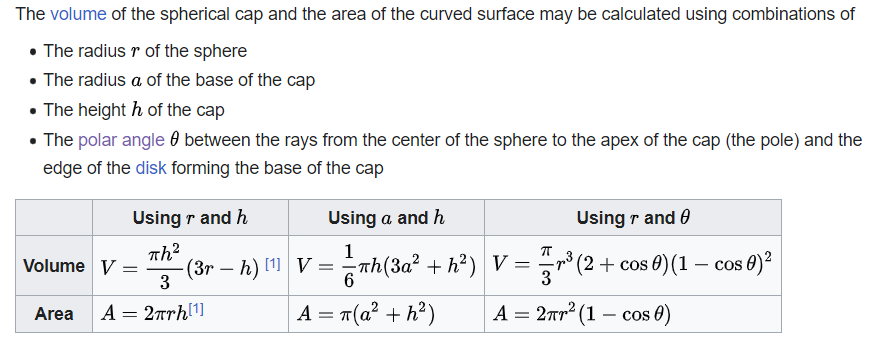Search the Community
Showing results for tags 'totes'.
-
Since I've read the preview chapters of TotES, I was wondering how big and how far away Lumar's moons have to be to create the world Brandon envisioned. So here I am, finally after reading the book, I can do the math myself and answer that burning question. The book gave us 2 very important pieces of information that makes this math possible. So let's dive into this. I won't focus on the exact orbit of moons as this was already greatly showed in this topic: For me, it is important that only one moon is visible from each sea of spores and that when crossing between two seas, both moons are visible for a short time, before one of them will set behind a horizon. So moons can't be in a geostationary orbit, they have to be in orbit around the entire sphere of the planet. So no matter where you are on the surface of the planet, you can see at least one moon. The second piece of information, mentioned multiple times in the book, is that moons take 1/3 of the sky. That's a lot. And here we can start doing our math. Bear in mind, I'm not that good in math, so there are mistakes here (few of them I'm aware about), but I think this will give us nice approximations of the size and distance of Lumar's moons. For now, to have a good comparison, let's assume that each Lumar moon is the size of the Earth Moon. For the Moon to take 1/3 of the sky, he would need to be much closer than it is. And we can calculate how far he needs to be, based on the angular size. Right now, the Moon has an angular size of around 0.5 degree. On Lumar, it would need to have 60 degrees (that's 1/3 of the 180 degrees). And the formula for angular size is: Angular size in degrees = (size * 57.29) / distance. We have the size of the moon (diameter = 3,474.8 km), we have angular size (60 degrees), we can reposition the equation to search for the distance. distance = (size * 57.29) / Angular size in degrees = 3317,85 km. That's how far away Lumar's moon the size of Earth's Moon would need to be to cover 1/3 of the sky. That's almost 1:1 proportion between size and distance. But Lumar's moons can't be the size of Earth's Moon. Because only one of them is visible for each sea of spores. The crossing between two seas is very short, and as soon as you cross into a different sea, the moon of the previous sea disappears behind the horizon. Which means we need to look into how much is hidden behind the curve of the Lumar's surface, as this hidden amount would be equal to the distance between Lumar and moon plus the size of a moon (when standing on the edge of a sea of spores). So for simplicity we can assume that moons are like a tower or a mountain stretching from the surface of the planet, obscured by the curvature. Because there are 12 moons and 12 seas covering the entire planet, 1 sea covers 1/12 of the planet's surface. Assuming that Lumar has the same size as Earth: Earth's surface = 510100000 km^2 Surface of one sea of spores = 510100000 / 12 = 42508333,33 km^2 So assuming that each sea is circular (which has its own problems, as you can't divide surface of a sphere into circles without them overlapping, so here each sea would have to be bigger than 1/12, and each sea has a pentagonal shape, but let's ignore it for simplicity), each sea of spores would be a surface of a spherical cup. When standing on the edge of this circular sea of spores, the moon of that sea would be fully just under the horizon of the planet. Here I'm looking for the length of the arch L, so I can use it as a distance between observer and observable object in curve calculator (which, as I see now, gives me another problem, because the distance between observer and observable object behind a curve of the planet is a straight, shortest line between them, not an arch along the surface of the planet, but I don't know how to get that line without having other values like height of observable object etc, so yeah, I did ignore that as well). Using the equations presented above for a spherical cup, I have the Area of that cup (1/12 of Earth's surface), the radius of the sphere (Earth's radius R = 6371 km), and pi = 3,1415 so from this I can calculate all values a, h, and angle θ, and from that I can get length of the arch L, L=R*θ. Doing the math, I got: a = 3521,81 km, h = 1061,91 km, angle θ = 0,585706545, and L = 3731,54 km. And now having L, I can give it into a curve calculator, which would calculate the hidden height of an object visible behind the horizon (assuming observer height of 10 m, standing on the deck of a ship) - https://www.metabunk.org/curve/ This gave me the value of the hidden height taking into account refraction of 878.62 km. This is the sum of the diameter of Lumar's moon and its distance from the surface of the planet. And here we can go back to the angular size: Angular size in degrees = (diameter * 57.29) / distance. Now assuming we're standing right under a moon, we know that the distance from the surface of Lumar to the other side of that moon is 878.62 km, and this is equal to diameter + distance. We need to only have diameter in the equation of angular size, so distance = 878.62 km - diameter, therefore: Angular size in degrees = (diameter * 57.29) / (878.62 km - diameter). And the angular size is 60 degrees, so changing the equation to have diameter on one side we get: 60 / 54.29 = diameter / (878.62 km - diameter) 1.05 = diameter / (878.62 km - diameter) diameter = 1,05 * 878.62 km / 2,05 Diameter of the moon, right below it, is equal to 450,02 km. And the distance between the surface of the planet and a moon is equal to 428,6 km. That's small, and very close to the surface. And here perspective would cause a lot of problems, as the further away you are from that moon, the smaller it is in the sky. And when you are 1000 km away from that moon, its angular size is already only around 30 degrees, as that's twice as far, 2000 km - 15 degrees, closer to the edge of the sea of spores 3000 km, and has only 10 degrees of angular size. Nobody in the book ever mentioned a moon shrinking or growing in size in the sky, and this had to be done. Moons can't be further away from the surface of Lumar than 878.62 km, as they would be visible from multiple spore’s seas at once. They can't be on Lumar's geostationary orbit (same as Earth's, around 36,000 km), as again, they would be visible from multiple seas at once, almost from one pole to the other. But only one moon is visible on a one sea, and it hides below the horizon as soon as you leave that sea. This means Lumar's moons have to be very close to the planet, and thus very susceptible to perspective. It's weird that Tress never was amazed by the Emerald moon shrinking, or the Crimson moon growing in size in the sky, as this should be happening, nor did Hoid mention it. Even right below the Crimson lunagree, nobody mentioned that the Crimson moon is huge, like nowhere else on the Crimson sea. And these are very drastic changes, hard to miss. We've been told only that moons take 1/3 of the sky, and that's it. Knowing now that the angular size of the moons changes with the distance, we can assume that moons can be bigger than 450,02 km, by decreasing the distance between them and Lumar's surface, but they can't be bigger than 878.62 km (as they would be touching the planet's surface). But this is basically a slide now, the bigger the moons, the closer they get to the planet's surface, the less changeable they're by perspective from a far away, but if you get too close to it, it will cover most of the sky instead, not just 1/3. So there is no good solution to it. Ignoring this blazing problem, I will now calculate the Roche limit for the Lumar - moon system. Roche limit is the distance from a celestial body within which a second celestial body, held together only by its own force of gravity, will disintegrate because the first body's tidal forces exceed the second body's self-gravitation. For the rigid, solid satellites: Assuming that Lumar's moons have a density of similarly sized moons in our Solar System (Mimas ~400 km, 1,15 g/cm^3), then Roche limit is 15367,61 km. Assuming that Lumar's moons have a density of Earth's moon (3,344 g/cm^3), the Roche limit for Lumar's moon is the same as the Moon, so ~9482 km. Now let's go crazy, assuming that Lumar's moons are made out of pure Osmium, the densest element on the periodic table (22,59 g/cm^3), and it's equally dense across its volume, the Roche limit would be equal to 5016,50 km. Which is still far too far to prevent Lumar's moons from disintegrating. How dense would Lumar's moons have to be, for their surface, closest to Lumar, to be on the Roche limit (making spores fall on the planet), but the rest of the moon to be on a "stable" orbit? So changing the equation and finding the density of the satellite, gave me the value of 36222,46 g/cm3 - which is comparable to a white dwarf star's density (between 10^4 and 10^7 g/cm^3)! That's just crazy!!! A moon with the diameter of 450,02 km and this density, would have a mass of 1,73 * 10^24 kg, which is "only" 3.45 times less than Earth's mass. Therefore all of Lumar's moon would be 3.5 times more massive than Lumar's planet itself. Also, they would be extremely bright and hot. And I don't even want to know what would happen with the orbits of Lumar's system if that was the case. So that's definitely not possible. But that's the only way in which Lumar's moons won't be disintegrated by Lumar's gravity, be that close to its surface, and also make spore fall on the surface of the Lumar "naturally". That's enough math for me. That was a fun Sunday, all of this to prove that Lumar's moons are impossibly close to Lumar's surface, far beyond their Roche limit, on orbits that can't exist in real life. Like we didn't know that already. But still, having some numbers for it is so much more fun (I'm a very weird person). Of course, keep in mind that spore seas aren't spherical, the distance between observer and a moon isn't the same as the distance between observer and the base of a lunagree, going along the surface planet, like I assumed in these calculations, but I think that these calculations provide a close enough approximation of the size and distance of Lumar's moons, to make it "useful". All of my calculations are done in a very chaotic Excel, in which I already got lost, but I'm almost certain there are no basic calculation errors there but feel free to check it out (I hope so, tomorrow I won't recognise that spreadsheet). And so here it is, the answer to the question that has been keeping me from sleeping at night for the whole year. How unrealistic is the Lumar planetary system? The answer is - very unrealistic. Thank you for reading this far, if you enjoyed it, you're as crazy as I'm.
-
Hey! I am currently rereading both stress and TLM on a beautiful beach in Egypt ( too much lore to digest in one go) I am drawn back to the comment where about implied that he and sixteen other people chattered Ado as they could not trust him to make his own decisions. My head cannon has always been (since Dawnshard anyway) that there would have been twenty people in total, 4 for the Dawnshard and 16 for each Shard. I am aware that Hoid was offered a shard and did not take this up. I wonder why there were seventeen people originally, did one person never intend to take up a shard? Was there an additional purpose for that person? I just think it’s random that they had one extra person lying around to take up the refused shard. I am wondering if Hoid declined the shard before they attempted the shattering but still wanted to be involved in the attempt. Any thoughts would be greatly appreciated? I feel I have missed a link somewhere.
- 25 replies
-
7
-
- spoilers
- discussion
-
(and 2 more)
Tagged with:
-
So now we've had our first in book appearance of a Dragon in TotES and learned that various parts, horns, teeth etc are made of actual Dragonsteel do we think that if we ever see Cultivation in her Dragon form that her horns & teeth would appear as Dragonsteel or would they be made of her god metal (Koravalliumium??)? I'm not sure if we'd be able to tell unless we ever see her god metal but I think it would be a cool touch if we were to ever see her in Dragon form.
-
So, just reached chapter 22 in Tress, and Hoid explicitly says that he ate a [R]ock and had to fight off it's family. Conclusion: Hoid turned into a kandra, killed Rock, ate him, then fought off his family. Ta da! First official sp1 theory maybe probably not.







